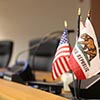Teacher Does Not Have Constitutional Right To Display Banners Containing Religious References In The Classroom

September 2011
Number 51
�In Johnson v. Poway Unified School District (9th Cir. 2011) ___ F.3d ___, the Ninth Circuit Court of Appeals reversed a trial court ruling and held thePowayUnifiedSchool District(District) did not violate a high school teacher's free speech rights when it ordered him to remove two banners containing religious references from the walls of his classroom.
For approximately two decades, Bradley Johnson, a math teacher in the District, had displayed two banners in his classroom measuring approximately seven feet by three feet, one with the phrase "In God We Trust," "One Nation Under God," "God BlessAmerica," and the other with the phrase "All Men Are Created Equal, They Are Endowed By Their CREATOR." Mr. Johnson's principal ordered him to remove the banners after an inquiry from a fellow teacher and a decision by the school board directing him to remove the banners. The principal told Mr. Johnson the banners were impermissible because they conveyed a Judeo-Christian viewpoint. Mr. Johnson sued the District, asserting violations of his constitutional rights. The trial court held the District impermissibly restricted Mr. Johnson's speech based on viewpoint. For more on the lower court decision in the Johnson case, please see Client News Brief No. 11, April 2010.
On appeal, the Ninth Circuit reversed the decision and ruled the District did not infringe on Mr Johnson's First Amendment free speech rights by ordering him "not to use his public position as a pulpit from which to preach his own views on the role of God in our Nation's history to the captive students in his mathematics classroom."
The Ninth Circuit found the lower court erred in applying a pure First Amendment forum-based analysis, rather than the Pickering analysis developed by the United States Supreme Court to measure the constitutionality of a government employer's curtailment of a public employee's speech. (Pickering v. Board of Education of the Township High School District (1968) 391U.S.563.) Based on the precedent of the Pickering case, the court looked at several factors. The first two factors are: (1) whether the speech involved a matter of public concern; and (2) whether the speech was made as a private citizen or as a public employee.
Mr. Johnson's organization of the banners and their selected emphasis on the words "God" and "Creator" drove the court to its conclusion that the banners concerned religion and were therefore a matter of public concern, satisfying the first factor of the analysis.
The court then considered whether Mr. Johnson "spoke as a private citizen" or as a "public employee." If he spoke as any ordinary citizen might, then the court would continue its application of the Pickering test. But if Mr. Johnson's speech "owe[d] its existence" to his position as a teacher, then he spoke as a public employee, not as a citizen, and the District could limit his speech.
The court found that Mr. Johnson did not act as a citizen when he went to school and taught class, took attendance, supervised students, and regulated their comings-and-goings; he acted as a teacher - a public employee. Noting that teachers hold positions of trust and authority, and that they interact with students with impressionable young minds, the court found that teachers necessarily act as public officials for purposes of a Pickering inquiry when at school or school functions, in the general presence of students.
The court held that Mr. Johnson took advantage of his position to press his particular views upon the impressionable and "captive" minds before him. For these reasons, the court concluded that Mr. Johnson spoke as an employee, not as a citizen, and the District was free to limit his speech. The court did not go any further in its Pickering analysis since the second factor was not met. Finally, the court held the District had not violated the Establishment Clause, which requires a separation of church and state, because Mr. Johnson's banners were clearly religious.
This case provides guidance on the issues of employee speech in the classroom and employee religious freedom. Specifically, it demonstrates the test that the 9th Circuit will use in determining whether a school district has lawfully limited an employee's speech. The facts of each case must be analyzed individually to determine whether an employer's actions could implicate an employee's free speech rights.
If you have any questions, please contact one of our eight offices located statewide or consult our website.
Written by:
Roberta Rowe
Shareholder
Fresno Office
rrowe@lozanosmith.com
ReginaGarza
Associate
Fresno Office
rgarza@lozanosmith.com
2011 Lozano Smith
Number 51
�In Johnson v. Poway Unified School District (9th Cir. 2011) ___ F.3d ___, the Ninth Circuit Court of Appeals reversed a trial court ruling and held thePowayUnifiedSchool District(District) did not violate a high school teacher's free speech rights when it ordered him to remove two banners containing religious references from the walls of his classroom.
For approximately two decades, Bradley Johnson, a math teacher in the District, had displayed two banners in his classroom measuring approximately seven feet by three feet, one with the phrase "In God We Trust," "One Nation Under God," "God BlessAmerica," and the other with the phrase "All Men Are Created Equal, They Are Endowed By Their CREATOR." Mr. Johnson's principal ordered him to remove the banners after an inquiry from a fellow teacher and a decision by the school board directing him to remove the banners. The principal told Mr. Johnson the banners were impermissible because they conveyed a Judeo-Christian viewpoint. Mr. Johnson sued the District, asserting violations of his constitutional rights. The trial court held the District impermissibly restricted Mr. Johnson's speech based on viewpoint. For more on the lower court decision in the Johnson case, please see Client News Brief No. 11, April 2010.
On appeal, the Ninth Circuit reversed the decision and ruled the District did not infringe on Mr Johnson's First Amendment free speech rights by ordering him "not to use his public position as a pulpit from which to preach his own views on the role of God in our Nation's history to the captive students in his mathematics classroom."
The Ninth Circuit found the lower court erred in applying a pure First Amendment forum-based analysis, rather than the Pickering analysis developed by the United States Supreme Court to measure the constitutionality of a government employer's curtailment of a public employee's speech. (Pickering v. Board of Education of the Township High School District (1968) 391U.S.563.) Based on the precedent of the Pickering case, the court looked at several factors. The first two factors are: (1) whether the speech involved a matter of public concern; and (2) whether the speech was made as a private citizen or as a public employee.
Mr. Johnson's organization of the banners and their selected emphasis on the words "God" and "Creator" drove the court to its conclusion that the banners concerned religion and were therefore a matter of public concern, satisfying the first factor of the analysis.
The court then considered whether Mr. Johnson "spoke as a private citizen" or as a "public employee." If he spoke as any ordinary citizen might, then the court would continue its application of the Pickering test. But if Mr. Johnson's speech "owe[d] its existence" to his position as a teacher, then he spoke as a public employee, not as a citizen, and the District could limit his speech.
The court found that Mr. Johnson did not act as a citizen when he went to school and taught class, took attendance, supervised students, and regulated their comings-and-goings; he acted as a teacher - a public employee. Noting that teachers hold positions of trust and authority, and that they interact with students with impressionable young minds, the court found that teachers necessarily act as public officials for purposes of a Pickering inquiry when at school or school functions, in the general presence of students.
The court held that Mr. Johnson took advantage of his position to press his particular views upon the impressionable and "captive" minds before him. For these reasons, the court concluded that Mr. Johnson spoke as an employee, not as a citizen, and the District was free to limit his speech. The court did not go any further in its Pickering analysis since the second factor was not met. Finally, the court held the District had not violated the Establishment Clause, which requires a separation of church and state, because Mr. Johnson's banners were clearly religious.
This case provides guidance on the issues of employee speech in the classroom and employee religious freedom. Specifically, it demonstrates the test that the 9th Circuit will use in determining whether a school district has lawfully limited an employee's speech. The facts of each case must be analyzed individually to determine whether an employer's actions could implicate an employee's free speech rights.
If you have any questions, please contact one of our eight offices located statewide or consult our website.
Written by:
Roberta Rowe
Shareholder
Fresno Office
rrowe@lozanosmith.com
ReginaGarza
Associate
Fresno Office
rgarza@lozanosmith.com
2011 Lozano Smith
As the information contained herein is necessarily general, its application to a particular set of facts and circumstances may vary. For this reason, this News Brief does not constitute legal advice. We recommend that you consult with your counsel prior to acting on the information contained herein.





